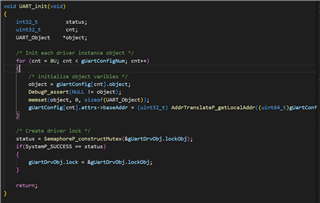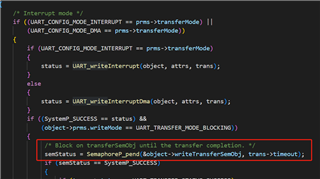Part Number: TMDS62LEVM
Tool/software:
Hi,
I have a question regarding UART_init() function, or any other similar functions for other peripherals

From TI's example code perspective, it looks like the prefer way is to initialize all needed uarts at once. However, for our use case, we will only initialize one uart at a time, while keeping the debug uart on all the time so can print some error msgs like "overrun" etc., which is more a structure like
user_uart_init(uartn)
{
initialize uart pin based on uartn ;
enable uart clk based on uartn;
UART_init();
UART_open();
return uart_handle;
}
user_uart_init(console_uart);
user_uart_init(uart5);
Will the mutex gUartDrvObj in the driver cause some potential unexpected behaviors if we initialize one by one? Like when uart5 is communicating in interrupt mode/polling mode but get some errors, debug uart won't be able to print?

Thanks,
Dazong

